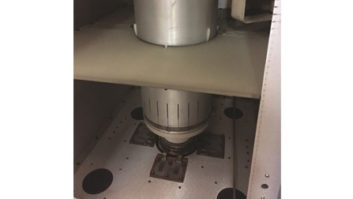A mentor of mine, Neil Muncy, frequently used the phrase, “Tune for maximum smoke,” referring to the adjustment of any parameter with a bell-curve characteristic. In other words, optimal results occur when just the right amount is applied — too much or too little both cause a drop in performance. (Back then, setting the bias on an analog tape recorder was a perfect example of this.)
As any engineer knows, the tuning of a resonant circuit follows a similar process, with maximum output occurring when the circuit is in resonance at a specific frequency — reduced output occurring when the circuit operates either above or below that frequency. The steepness of the curve, or the “touchiness” (sensitivity) of the adjustment, is called the Q of the circuit, with a “high-Q” circuit exhibiting a very sharp bell-curve characteristic, and a “low-Q” circuit being broad and forgiving.
Thus the higher the Q, the greater difference a small change in a single variable makes. Such highly resonant circuits may also be prone to uncontrolled resonance (destructive feedback or oscillation), and thus overload or failure.
Keep these fundamental engineering tenets in mind as we explore some other, non-electronic but similar situations.
Dialing for dollars
Back in the day, most food was produced on “family farms,” which typically included a variety of crops and livestock. A well-run farm was a highly symbiotic affair, with some of the crops used for feeding the livestock, and the livestock’s manure in turn used to fertilize the crops.

Today, however, this process has been broken into component parts, and each has been optimized for maximum cost-effectiveness. Crops are each produced in isolation on mega-industrial farms, and livestock are managed in “feed lots.” The outputs of each are massive, and result in the relatively low costs for food that we currently enjoy (not to mention profitability for the operations’ owners).
But each has problems: The feed lots have extremely challenging waste-management problems (to which anyone with a functioning olfactory system who has driven within a few miles of one can attest — even in the dead of winter). Meanwhile, the mega-farms use large amounts of chemical fertilizers, the runoff from which can produce serious side effects to the local water supply.
So tweaking these processes purely for economic performance has created potential sustainability and environmental issues, making the whole set of enterprises highly susceptible to a single point of failure. These “high-Q” systems have little agility to adapt to contextual changes around them.
The conditional shifts provoking such collapses are also not unheard of. Consider another, lesser-known example, off the Namibian coast in the South Atlantic, west of southern Africa. Years of overfishing in the area have produced an excess of plankton, which would normally have been consumed by fish. The large amounts of unconsumed plankton eventually die and accumulate on the ocean floor, where natural decomposition produces large amounts of hydrogen sulfide (H2S) gas, which forms bubbles in the water.
When storms come to the area, the localized reduction in atmospheric (barometric) pressure also reduces the underwater pressure, causing the H2S bubbles to aggregate and float toward the surface, whereupon lightning strikes on the ocean surface explode the bubbles. This in turn further reduces underwater pressure, and does so in a precipitous fashion. These sudden drops in pressure at the ocean floor cause volcanic eruptions to occur there (geological conditions make the area particularly prone to such activity).
The eruptions further reduce pressure over an even wider area, sending shock waves outward, causing a chain reaction of similar eruptions across hundreds of square miles of the ocean floor — areas so large they are clearly visible to satellites orbiting overhead.
The large amounts of H2S and methane gas released cause massive fish kills (not to mention the noxious odor for humans on nearby shores), further reducing fish populations in the area and worsening the root cause of the problem.
Meanwhile, the gases released into the atmosphere increase the greenhouse effect, potentially causing more storms in the area from atmospheric heating, further exacerbating the problem by triggering more pressure reductions, explosions and eruptions.
This shows how a high-Q system can be devastated by a single, peripheral event. These fragile processes are rendered unstable by imbalances in the system, thereby reducing their agility to adapt even small subsequent environmental changes. The high Q can also act as an accelerant, making the rate of such change faster than anyone could have predicted from previous models.
If this sounds familiar, it should. The same process can explain what has befallen the world’s economic system in the last few months, as a result of the development of high-Q instruments and behaviors in the “financial engineering” sector.
Bringing it home
What does this have to do with radio, you ask? Well, if you haven’t made the connection yet, this industry has built its own highly resonant circuit, tuned for maximum dollar-generation from a single process, as well.
Radio groups have grown very large, and are just that: radio (only) groups, with little diversification and therefore not much ability to accommodate rapid change in their environment.
The addition of large debt loads has further narrowed the Q in this equation, acting as a global-warming like accelerant. Any agility to compensate for change that might exist is limited by the simultaneous occurrence of tightened credit and reduced advertising revenues.
The fact that the radio industry is still controlled by a multiplicity of owners (albeit far fewer than in the past) is one saving grace, since it could be argued that some groups will have better luck than others in returning their systems to stability. Any randomization (“noise”) in the circuit is a good thing here. In this respect, perhaps satellite radio is the poster child for the current crisis, having built itself the highest-Q tank circuit in the radio business sector.
Nevertheless, terrestrial radio remains in its own highly resonant state, and is at some risk of descent into oscillation. Recalling Muncy’s rule, let’s hope that the industry’s current tuning process doesn’t send its own fortunes up in smoke.
Skip Pizzi is contributing editor of Radio World.












